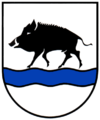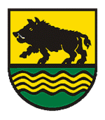Wild boar
| Wild Boar | |
|---|---|

| |
| Scientific classification | |
| Kingdom: | |
| Phylum: | |
| Class: | |
| Order: | |
| Family: | |
| Genus: | |
| Species: | S. scrofa
|
| Binomial name | |
| Sus scrofa | |
The wild boar (Sus scrofa) is the wild ancestor of the domestic pig. It is native in woodlands across much of Central Europe, the Mediterranean Region (including North Africa's Atlas Mountains) and much of Asia as far south as Indonesia, and has been widely introduced elsewhere. It is in the same Suidae biological family as the Warthog and Bushpig of Africa, the Pygmy Hog of northern India, Babirusa of Indonesia and others. It is more distantly related to the peccary (or javelina) found in the southwestern area of North America and throughout Central and South America.
Wild boars have a confirmed maximum weight of 900 lbs (with unverified reports of heavier individuals[1]) for adult males, and can be up to 9 feet. If surprised or cornered they may become aggressive - particularly a sow with her piglets - and if attacked will defend themselves vigorously with their tusks.
The wild boar became extinct in Great Britain and Ireland by the 17th century, but wild breeding populations have recently returned in some areas, particularly the Weald, following escapes from boar farms.
Wild or feral
The difference between the wild and domestic animals is largely a matter of perception; both are usually described as Sus scrofa, and domestic pigs quite readily become feral. The characterisation of populations as wild, feral or domestic and pig or boar is usually decided by where the animals are encountered and what is known of their history. In New Zealand for example, wild pigs are known as "Captain Cookers" from their supposed descent from liberations and gifts to Māori by explorer Captain James Cook in the 1770s.
The term boar is used to denote an adult male of certain species, including, confusingly, domestic pigs. In the case of wild pigs only, it is correct to say "female boar" or "infant wild boar", since boar or wild boar refers to the species itself.

One characteristic by which domestic breed and wild animals are differentiated is coats. Wild animals almost always have thick, short bristly coats ranging in colour from brown through grey to black. A prominent ridge of hair matching the spine is also common, giving rise to the name razorback in the southern United States. The tail is usually short and straight. Wild animals tend also to have longer legs than domestic breeds and a longer and narrower head and snout. European adult males can be up to 200 kg (sometimes up to 300 kg in certain areas, particularly Eastern Europe) and have both upper and lower tusks; females do not have tusks and are around a third smaller on average. (Compare "Hogzilla", a very large boar shot in Georgia, USA in 2004.)
Habits

Wild boars live in groups called sounders. Sounders typically contain around 20 animals, but groups of over 50 have been seen. In a typical sounder there are two or three sows and their offspring; adult males are not part of the sounder outside of a breeding cycle, two to three per year, and are usually found alone. Birth, called farrowing, usually occurs in a secluded area away from the sounder; a litter will typically contain eight piglets, but up to 13 have been known.
The animals are usually nocturnal, foraging from dusk until dawn but with resting periods during both night and day. They eat almost anything they come across, including nuts, berries, carrion, roots, tubers, refuse, insects, small reptiles--even young deer and lambs.
Subspecies

- Sus scrofa scrofa - North Africa, Europe, and Asia
- Sus scrofa ussuricus - North Asia and Japan
- Sus scrofa cristatus - Asia Minor to India
- Sus scrofa vittatus - Southeast Asia to Indonesia; sometimes merged into S. s. cristatus
- Sus scrofa taiwanus - inhabits Taiwan
Mythology and religion
In Greek mythology two boars are particularly well known. The Erymanthian Boar was hunted by Hercules as one of his Twelve Labours, and the Calydonian Boar was hunted in the Calydonian Hunt by dozens of other mythological heroes, including some of the Argonauts and the huntress Atalanta.
In Celtic mythology the boar was sacred to the goddess Arduinna [2] [3], and boar hunting features in several stories of Celtic and Irish mythology. One such story is that of how Fionn mac Cumhaill ("Finn McCool") lured his rival Diarmuid Ua Duibhne to his death - gored by a wild boar.
The Norse gods Freyr and Freyja both had boars. Freyr’s boar was named Gullinbursti ("Golden Mane"), who was manufactured by the Sons of Ivaldi as a gift to Freyr. The bristles in Gullinbursti’s mane glowed in the dark to illuminate the way for his owner. Freya rode the boar Hildesvini (Battle Swine) when she was not using her cat-drawn chariot. According to the poem Hyndluljóð, Freyja concealed the identity of her protégé Ottar by turning him into a boar. In Norse Mythology, the boar was generally associated with fertility as well as a protective talisman in war, due to the animal’s sometimes fierce nature.
In Persia (Iran) during Sassanid Empire, boars were respected as fierce and brave creatures and the adjective "Boraz (Goraz)" meaning Boar was sometimes added to a person's name to show his bravery and courage. The famous Sassanid spahbod, Shahrbaraz, who conquered Egypt and the Levant, had his name derived Shar + Baraz meaning "Boar of the Kingdom" 3 boars are seen on the Grimsby coat of arms.
Also, in Hindu mythology, the third avatar of the Lord Vishnu was Varaha, a boar.
In Chinese horoscope the boar (sometimes also translated as pig), is one of the twelve animals of the zodiac, based on the legends about its creation, either involving Buddha or the Jade Emperor.
Heraldry and other symbolic use
The boar and a boar's head are common charges in heraldry.
A complete beast may represent what are seen as the positive qualities of the boar, namely courage and fierceness in battle; a boar's head may represent hospitality (from the common provision of roast boar at banquets), or it may symbolise that the bearer of the arms is a noted hunter. [citation needed]
Scottish Highland Clan Campbell uses the boar on its badge to symbolize courage and fierceness. Clan Urquhart similarly uses three boars' heads on its coat of arms.
The wild boar was a symbol of Richard III of England.
However boar charges also lend themselves very well to canting (heraldic punning). The German towns of Eberbach and Ebersbach an der Fils, both in Baden-Württemberg, and Ebersbach, Saxony use civic arms that demonstrates this. Each depicts a boar - Eber in German (and in two cases a wavy fess or bars meant to represent a brook - Bach in German).
In Belgium, the wild boar is the symbolic animal of the Ardennes forests in the south of the country, and is the mascot of one of the Belgian Army's premier infantry regiments, the Chasseurs Ardennais, the soldiers of which wear a boar's head pin on their beret.
-
Badge of Clan Campbell, Scotland -
Arms of Ebersbach an der Fils, Germany -
Arms of Ebersbach, Saxony, Germany
Hunting


A full sized boar is a large strong animal armed with sharp tusks which defends itself strongly; so hunting has often been a test of bravery.
Historically, boar hunting was done by groups of spearmen using a specialised boar spear. The boar spear was fitted with a cross guard to stop the enraged animal driving its pierced body further down the shaft in order to attack its killer before dying. Specialised boar swords were also used in boar hunting, and also large hunting dogs, which would usually be equipped with heavy leather armour. See also medieval hunting.
In Persia aristocratic hunters used elephants to chase the boars and encircle them in marshland. The hunter would then use a bow to shoot the boars from a boat. Elephants carried the bodies to the hunting camp. The rock reliefs of these scenes have remained largely intact in Taq-e Bostan.
In India, hunting from horseback ("pig-sticking")[4] was popular among the maharajas, and with British officers during Victorian and Edwardian times. Robert Baden-Powell, founder of the Scouting movement wrote a book[5] on the subject.
Currently wild boars are hunted both for their meat and to mitigate the damage they cause to crops and forests. It has been said that one "only gets one shot" at a charging boar, because its hide is quite thick, its bones are quite dense, and anything less than a "kill shot" will allow the boar to continue its charge, which it will: hunters have reported being butted up into trees by boars that have already taken a glancing shot.
Generally dogs are used, sometimes now wearing Kevlar vests, to track and subdue their quarry, which is then despatched using a knife, rifle or bow. In several countries such hunting is a popular recreation, known as "pig hunting" in Australia and New Zealand[6][7], and "hog hunting" in the South of the United States[8], where the Blackmouth Cur is one breed of dog used.
Weiser Weight and Tusk Trophy Wild Boar Record Book Wild Boar Records are kept by the "Weiser Weight & Tusk" scoring system or "WWT," and it works as follows:
Developing a fair and simple method to score wild boars focused was placed on the most basic and most popular characteristics that all hunters look for in a trophy or "record book" wild boar. These two attributes are body weight and tusk size. Weiser Weight & Tusk is a scoring system to rank wild boars that gives both characteristics "separate but equal" representation.
In using the WWT system, only the weight of the boar and the size of his bottom tusks are figured into the score. Detailed rules and the various categories can be found here: Official Rules and Category Links
Commercial use

The hair of the boar was often used for the production of the toothbrush until the invention of synthetic materials in the 1930s. The hair for the bristles usually came from the neck area of the boar. Popular because the bristles were soft, it wasn't the best material for oral hygiene as the hairs were slow to dry and usually retained bacteria. Boar hair is also used in the manufacture of the boar bristle hairbrush. Boar bristles continue to be used in the manufacture of premium dart boards for use with steel-tipped darts: a large quantity of bristles are aligned parallel to each other and compressed in a circular band of steel to form the board.
Boar meat (pork) is eaten as food in several countries. Boars are sometimes farmed for their meat.
See also

External links
- Least Concern species
- Pigs
- Mammals of Europe
- Mammals of the United States
- Fauna of Mexico
- Mammals of Central America
- Fauna of Morocco
- Fauna of Algeria
- Fauna of Egypt
- Fauna of Sudan
- Fauna of Korea
- Fauna of China
- Fauna of Iran
- Fauna of Indonesia
- Fauna of the Middle East
- Fauna of the Indian Subcontinent
- Fauna of Southeast Asia
- Mammals of Brazil
- Fauna of Uruguay
- Fauna of Paraguay
- Fauna of Argentina
- Fauna of Peru
- Fauna of the Guianas
- Fauna of Venezuela
- Fauna of Colombia
- Fauna of Ecuador
- Fauna of Chile
- Fauna of Guatemala
- Fauna of Honduras





